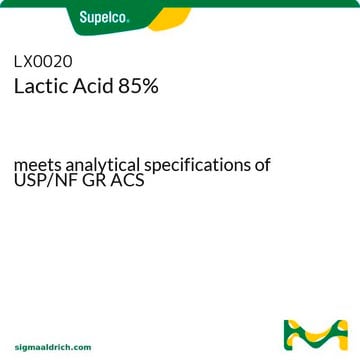L6661
Lactic acid
meets USP testing specifications
Synonyme(s) :
DL-Lactic acid, 2-Hydroxypropionic acid
About This Item
Produits recommandés
Agence
USP/NF
meets USP testing specifications
Pureté
88.0-92.0%
Forme
viscous liquid
Indice de réfraction
n20/D 1.425 (lit.)
pH
2
Point d'ébullition
122 °C/15 mmHg (lit.)
Densité
1.209 g/mL at 25 °C (lit.)
Traces de cations
heavy metals: ≤0.001%
Application(s)
pharmaceutical (small molecule)
Température de stockage
room temp
Chaîne SMILES
CC(O)C(O)=O
InChI
1S/C3H6O3/c1-2(4)3(5)6/h2,4H,1H3,(H,5,6)
Clé InChI
JVTAAEKCZFNVCJ-UHFFFAOYSA-N
Vous recherchez des produits similaires ? Visite Guide de comparaison des produits
Catégories apparentées
Actions biochimiques/physiologiques
Autres remarques
Mention d'avertissement
Danger
Mentions de danger
Classification des risques
Eye Dam. 1 - Skin Corr. 1C
Risques supp
Code de la classe de stockage
8A - Combustible corrosive hazardous materials
Classe de danger pour l'eau (WGK)
WGK 1
Point d'éclair (°F)
235.4 °F - closed cup
Point d'éclair (°C)
113 °C - closed cup
Équipement de protection individuelle
Eyeshields, Gloves, type ABEK (EN14387) respirator filter
Certificats d'analyse (COA)
Recherchez un Certificats d'analyse (COA) en saisissant le numéro de lot du produit. Les numéros de lot figurent sur l'étiquette du produit après les mots "Lot" ou "Batch".
Déjà en possession de ce produit ?
Retrouvez la documentation relative aux produits que vous avez récemment achetés dans la Bibliothèque de documents.
Les clients ont également consulté
Protocoles
Separation of DL-Lactic acid, ~90% (T)
Science Slam panel: Leading gene therapy developers discuss commercialization challenges and the importance of robust process development plans.
Chromatograms
application for HPLCapplication for HPLCNotre équipe de scientifiques dispose d'une expérience dans tous les secteurs de la recherche, notamment en sciences de la vie, science des matériaux, synthèse chimique, chromatographie, analyse et dans de nombreux autres domaines..
Contacter notre Service technique



